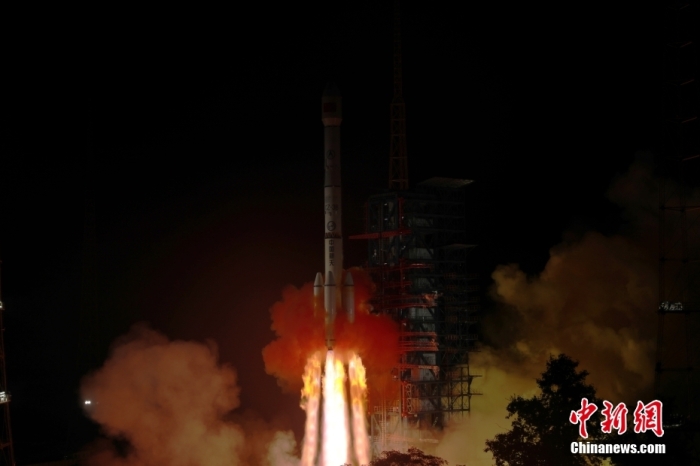China News Agency, Beijing, July 13 (Ma Shuaisha and Zhang Yin) On July 13, the Tianlian-2 03 satellite was successfully launched at the Xichang Satellite Launch Center on the Long March 3B carrier rocket.
After entering the orbit, the satellite will form a network with the previously launched Tianlian-2 01 and 02 satellites to form China's second-generation relay satellite system, improving China's space-based measurement and control and data relay capabilities.
At 0:30 on July 13, Beijing time, China used the Long March-3B carrier rocket at the Xichang Satellite Launch Center to successfully launch the Tianlian-203 satellite into the sky, and the satellite successfully entered the predetermined orbit. The launch mission was a complete success.
Photo by Qiu Lijun issued by China News Agency
The Fifth Academy of China Aerospace Science and Technology Corporation has carried out the research and development of Chinese relay satellites since 2003. In 2012, the Tianlian-1 Samsung network was realized, making China the second country in the world to have a relay satellite system that can cover the world.
Today, China has once again achieved the leap from the Tianlian-1 system to the Tianlian-2 system, writing a new chapter in the construction of China's data relay satellite system.
From scratch: measurement and control coverage increased from 18% to nearly 100%
Relay satellites are called "satellites of satellites", which can take advantage of the orbital height to "condescend" to track spacecraft operating in medium and low orbits, and transmit the obtained data back to the ground in real time, improving the use efficiency and efficiency of various satellites. emergency capability.
Before the "Skylink" relay satellite was put into use, China had been relying on land-based measurement and control stations and Yuanwang series ocean-going survey ships to support the launch, measurement and control and on-orbit communication tasks of spacecraft.
In 2003, the Shenzhou-5 spacecraft sent Yang Liwei into space. During the orbit, Yang Liwei had several "heaven and earth calls" with the ground. At that time, after receiving the spacecraft signal at the ground measurement and control station, he had to use a short time window to quickly communicate.
The rest of the time, the astronauts need to wait in the cabin for the next communication cycle.
From the intermittent communication in the past to the continuous transmission now, the Tianlian-1 relay satellite has realized China's "scratch" in the field of data relay satellites, and established the "Skynet" of information between heaven and earth.
In 2008, China's first data relay satellite, Tianlian-1 01, was successfully launched, which means that China's medium and low orbit spacecraft began to have a "transit station" for data in the sky.
The measurement and control coverage of the Shenzhou 7 spacecraft has thus increased from 18% to 50%, and researchers can observe the astronauts' on-orbit situation for nearly 50 minutes within an hour and a half.
From 2008 to 2012, Tianlian-1 satellites 01, 02, and 03 were successfully launched successively, completing the networking of China's first-generation relay satellites and achieving nearly 100% coverage for low-orbit users.
During the Shenzhou 10 mission in 2013, China's first "space teaching" lasted for nearly an hour, with continuous signals and clear pictures throughout the process.
With the successful launch of the Tianlian-1 05 satellite in 2021, the development of the first-generation relay satellite system has come to a successful conclusion.
From good to strong: double the transmission rate
In order to further enhance the data relay communication capability, China has carried out research on the Tianlian-2 satellite system while improving the Tianlian-1 system.
In 2019, Tianlian-2 01 satellite was successfully launched, which opened the prelude to the upgrading of China's relay satellite system.
Compared with Tianlian-1 using the Dongfanghong-3 satellite public platform, Tianlian-2 is developed based on the Dongfanghong-4 satellite public platform, with a larger load, better performance, and double the transmission rate.
Since the Tianlian-2 satellite was launched in orbit, it has cooperated with the Tianlian-1 system and is mainly used to provide data relay and measurement and control services for manned spacecraft such as spacecraft, space laboratories, and space stations, and can also serve medium and low orbit remote sensing. , surveying and mapping, meteorological and other satellites to provide measurement and control support for spacecraft launch.
During the launch of high-orbit communication satellites, some orbital arcs are in the blind spot of domestic ground measurement and control stations. In the past, means such as survey ships were usually used to ensure the safety of the measurement and control links in the launch section.
After the launch of the Zhongxing 6D satellite in April this year, the relay satellite directly transmits the measurement and control information back to the ground station, which fully verifies the feasibility of providing measurement and control services for high-orbit communication satellites through the relay satellite system, reducing satellite launches. Stage dependence on overseas measurement and control sites and survey ships.
After the Tianlian-2 Samsung network is established, the use of two global relay satellite systems will greatly alleviate the problem of coordinating the resources of the relay satellite system.
In the mission of the space station, the two-generation Skylink satellite system will build a reliable "sky road" for the space station and the ground station around the clock, escorting the life and work of the astronauts.
(Finish)

